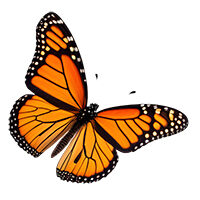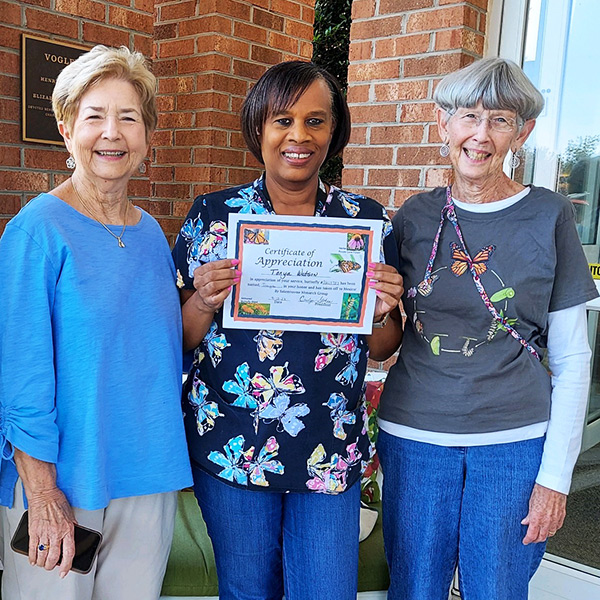 Salemtowne senior living community has a beautiful campus with abundant natural resources including walking trails, a lake, bountiful trees, and seasonal flowers that are enjoyed by residents, team members, and visitors alike. Thanks to a dedicated group of resident volunteers, Salemtowne’s campus has one more source of outdoor pride: magnificent Monarch butterflies.
Salemtowne senior living community has a beautiful campus with abundant natural resources including walking trails, a lake, bountiful trees, and seasonal flowers that are enjoyed by residents, team members, and visitors alike. Thanks to a dedicated group of resident volunteers, Salemtowne’s campus has one more source of outdoor pride: magnificent Monarch butterflies.
“I had been into Monarchs for 30 years and used to go caterpillar hunting with my granddaughter. The whole process from egg to caterpillar to butterfly is so much fun to watch,” said Salemtowne resident Carolyn Stokes. “After living at Salemtowne for a while, fellow resident Kay Snavely, who also had an interest in butterflies, said, ‘Let’s start a butterfly garden.'”
That was the genesis of the Monarch butterfly project at Salemtowne. Today, Salemtowne is home to officially sanctioned Monarch Waystation #31,679. The Waystation provides a proper habitat with the necessary resources for monarchs to produce successive generations and sustain their migration.
The Waystations at Salemtowne are a little more than 100 square feet each and are all located in areas that receive at least six hours of sun per day. Since Monarchs eat only milkweed, the Waystations have a minimum of 10 milkweed plants each and must be mulched, thinned, fertilized, and watered for optimum benefit to Monarchs. No insecticides are used, and invasive plants are removed by volunteer residents.
“One of the first things we had to learn was about the use of milkweed — and particularly that we shouldn’t use tropical milkweed, which is not good for Monarchs,” Carolyn said. “Over time, we’ve sparked a real interest in Monarchs at Salemtowne, and now we have good Monarch habitats all around Salemtowne’s campus.”
 Kay, who worked at the Bright Hope Butterfly Garden in Virginia prior to moving to Salemtowne, came up with the idea of tagging Monarchs to keep better track of them. Kay, Carolyn, and other residents discovered 16 Monarchs on Salemtowne’s campus during the first year of the butterfly project and were able to tag 15 of them. The second year, the number increased to 33 Monarchs with 30 of them tagged. Last year (the most recent year of the project), residents tagged 37 of the 39 Monarchs at Salemtowne.
Kay, who worked at the Bright Hope Butterfly Garden in Virginia prior to moving to Salemtowne, came up with the idea of tagging Monarchs to keep better track of them. Kay, Carolyn, and other residents discovered 16 Monarchs on Salemtowne’s campus during the first year of the butterfly project and were able to tag 15 of them. The second year, the number increased to 33 Monarchs with 30 of them tagged. Last year (the most recent year of the project), residents tagged 37 of the 39 Monarchs at Salemtowne.
“All the tags are numbers and are reported to Monarch Watch, which is a nationwide education, conservation, and research program that focuses on the Monarch butterfly,” Kay said. “Our group came up with the idea of tagging the butterflies with the names of team members at Salemtowne based on the longevity that they’ve worked here.”
“We even tagged a Monarch for our long-time Chaplain Linda Browne,” Carolyn added. “When Chaplain Browne retired last year, we had a Monarch chrysalis at her retirement party, and she was overjoyed.”
Also last year, Carolyn and Kay spearheaded a project to recognize the work longevity of Salemtowne’s team members by releasing dozens of butterflies to honor them. Their efforts were an enormous success at Salemtowne.
 “We honored 33 employees beginning with Cathleen Trinidad who had 34 years of service. In total, we celebrated 708 years of service! That is something to be very proud of, and I think the employees felt honored,” Kay said. “We tried to get the employees at the butterfly ‘launch’ in person, but sometimes that was difficult with weekend hours and night hours. We videoed those. We also tried to release the monarchs in all areas of Salemtowne so many residents could be a part of it.”
“We honored 33 employees beginning with Cathleen Trinidad who had 34 years of service. In total, we celebrated 708 years of service! That is something to be very proud of, and I think the employees felt honored,” Kay said. “We tried to get the employees at the butterfly ‘launch’ in person, but sometimes that was difficult with weekend hours and night hours. We videoed those. We also tried to release the monarchs in all areas of Salemtowne so many residents could be a part of it.”
“This was such a unique and meaningful way for residents to recognize my 23 years of service to Salemtowne,” said Carol Noah. “It took a lot of collaboration and effort on their part to recognize so many team members, and we all truly appreciated it.”
Carolyn, Kay, and dozens of other Monarch enthusiasts at Salemtowne are looking forward to the upcoming season, which begins in spring and concludes around Halloween. After October, the Monarchs will being their annual 2,000-mile journey from Salemtowne to Mexico where they will remain until the next migration season begins.
“Our ‘Monarch committee’ is filled with both women and men, some of whom are Master Gardeners, who have been enormously helpful with the preparation of the gardens and maintaining healthy habitats for butterflies,” Kay said. “It’s something that really brings Salemtowne residents together with a common and fun interest.”
There are seven official Monarch habitats at Salemtowne, but some residents maintain their own private habitats. The new chapter begins soon with the first meeting of the Monarch group in March to begin planning for another robust season of magnificent Monarchs of Salemtowne!
Monarch Facts
- The Monarch develops through complete metamorphosis with four distinct stages: egg, caterpillar, chrysalis, and adult.
- The first two or three generations of Monarchs only live two to six weeks. The super generation that migrates lives eight to nine months.
- The adult wingspan of a Monarch is four inches.
- If human beings grew like the Monarch caterpillar, the average person would be 14 feet, 7 inches tall and weigh 7,500 pounds.
- The Monarch makes the longest migration of any butterfly, which can be up to 3,000 miles.
- The orange of the Monarch’s wings is a warning color, indicating to predators that the butterfly will taste bad or may be toxic.
- A single Monarch caterpillar can consume an entire milkweed leaf in less than five minutes
- Monarchs fly at an average speed of 10-12 mph.
- In 1996, 97 Monarchs covered 45 acres of forests in Mexico. By 2016, they only covered 1.7 acres — an 84% decline.
- A Monarch butterfly can flap its wings up to 120 times a minute when trying to escape a predator.

